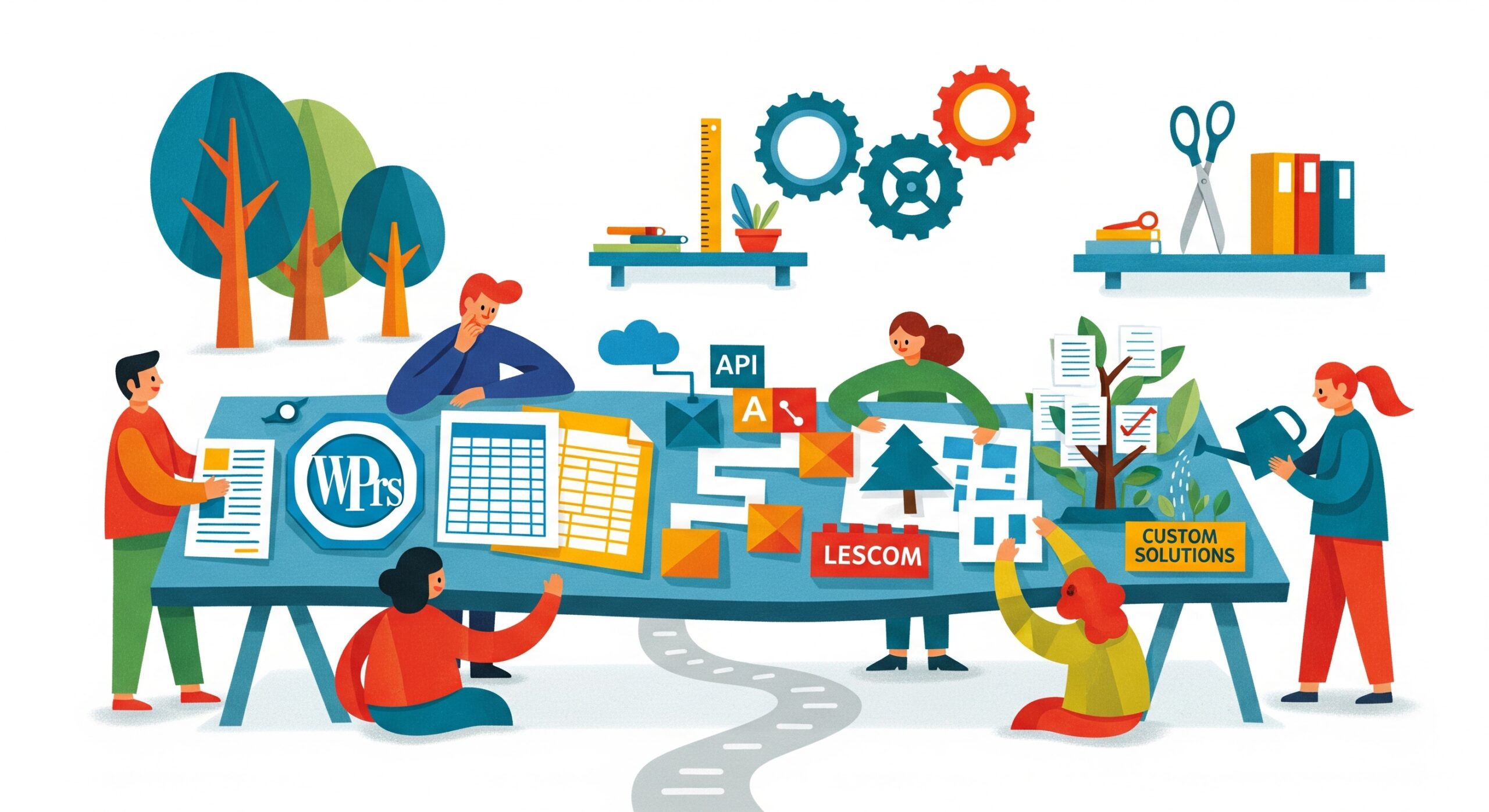Everyone talks about programmatic SEO like it’s some plug-and-play solution. Just pick a tool, generate thousands of pages, and watch the traffic roll in. That fantasy costs businesses hundreds of hours and thousands of dollars every year. The truth? Your best tech stack for programmatic SEO depends entirely on what you already know how to use and what you’re willing to learn.
7 Best Tech Stack for Programmatic SEO
1. WordPress + WP All Import + Google Sheets
This combination is the Honda Civic of programmatic SEO – not flashy, but it gets the job done every single time. You’re looking at maybe $200 total investment if you already have WordPress running. Google Sheets acts as your database (yes, really), WP All Import handles the heavy lifting of turning rows into pages, and WordPress does what it does best – publish content that Google actually likes.
What makes this stack particularly brilliant is its forgiving learning curve. Made a mistake in your template? Fix it in WordPress. Data needs tweaking? Jump back into Sheets. No APIs to debug, no complex workflows to untangle. The whole setup takes about 3 hours from scratch, including the inevitable coffee break when you realize you formatted your CSV wrong the first time.
2. Webflow + Whalesync + Airtable
Here’s where things get interesting – and expensive. You’re looking at roughly $150/month minimum, but what you get is programmatic SEO that actually looks good. Airtable becomes your content command center (think spreadsheets on steroids), Whalesync keeps everything in perfect sync, and Webflow makes sure your 10,000 auto-generated pages don’t look like they came from 2003.
The real magic happens when you start using Airtable’s filtered views and formulas. Suddenly you’re not just generating pages. You’re creating dynamic content that updates itself based on relationships between data points. It’s overkill for simple directory sites. Perfect for anything more complex.
3. Next.js Custom Build Solution
Let’s be honest – if you’re considering Next.js, you either have a developer on staff or you are one. This is the Ferrari of programmatic SEO software comparison options. Blazing fast, infinitely customizable, and capable of handling millions of pages without breaking a sweat.
But here’s what nobody tells you about custom builds: that initial two-week development sprint turns into six months of tweaks and optimizations and “just one more feature” requests. Still worth it? Absolutely, if you need features the other platforms can’t provide. Just budget three times what you initially think.
4. WordPress + Advanced Custom Fields
ACF (as the cool kids call it) transforms WordPress from a blogging platform into a legitimate content management powerhouse. You create custom field groups, map them to templates, and suddenly you’re generating location pages or product comparisons that would make enterprise CMS platforms jealous. All for about $49/year.
The learning curve hits different with ACF though. It’s not hard. It’s just… specific. You’ll spend your first week wondering why your repeater fields aren’t working (hint: you forgot to check “Show in REST API”), then suddenly everything clicks and you’re building complex content structures like it’s nothing.
5. Webflow CMS API Integration
This approach separates the builders from the tinkerers. You’re writing scripts to push content directly into Webflow’s CMS via their API. No middleman tools, no syncing delays. Just pure, programmatic efficiency. The setup requires actual coding knowledge, but once it’s running, you can generate and update thousands of pages with a single script execution.
Sound complex? It is. But the control you get is unmatched. Want to update 5,000 pages based on real-time data? Run the script. Need to A/B test different content variations? Write another function. This is one of the best platforms for programmatic SEO if you value flexibility over convenience.
6. Airtable + Zapier + Clay Stack
Picture this: Airtable holds your data, Clay enriches it with AI and external APIs, and Zapier glues everything together while you sleep. This stack feels like cheating. You’re essentially building a content factory that runs itself, pulling data from multiple sources and transforming it into SEO-optimized pages without writing a single line of code.
The monthly costs add up fast though – you’re looking at $200-300 minimum once you factor in all three services at useful tiers. Worth it if you’re generating revenue from day one. Painful if you’re still experimenting.
7. Bubble Dynamic Page Generation
Bubble is the wild card nobody expects in programmatic SEO conversations. It’s a no-code platform that somehow manages to handle dynamic page generation better than some traditional CMSs. You build your data structure visually, design templates with drag-and-drop, and deploy everything without touching code.
The catch? Bubble sites can feel sluggish compared to static site generators, and the SEO optimization requires extra attention. But for non-technical founders who need programmatic pages yesterday, it’s surprisingly capable. Just don’t try to scale past 50,000 pages unless you enjoy watching loading spinners.
Programmatic SEO Tech Stack Comparison Table
|
Stack |
Skill Level Required |
Approx. Cost (per month) |
Best For |
|---|---|---|---|
|
WordPress + WP All Import + Google Sheets |
Beginner / Low Code |
~$200 (one-time setup) |
Simple, budget-friendly setups using familiar tools |
|
Webflow + Whalesync + Airtable |
Intermediate / No-Code |
~$150 + |
Visually polished, dynamic sites needing clean design |
|
Next.js (Custom Build) |
Advanced / Developer |
Varies (>$500 setup typ.) |
Large-scale, high-performance deployments |
|
WordPress + Advanced Custom Fields (ACF) |
Intermediate / Low Code |
~$49 per year plugin |
Flexible WordPress builds (local pages, comparisons) |
|
Webflow CMS API Integration |
Developer / High-Code |
~$100–200 (depends on hosting) |
Full control & automated updates via API |
|
Airtable + Zapier + Clay Stack |
Intermediate / No-Code |
~$200–300 |
Automated data-driven content pipelines |
|
Bubble Dynamic Page Generation |
Beginner / No-Code |
~$30–70 |
Fast MVPs & non-technical founders needing quick launch |
Implementation Requirements and Setup Process
Data Collection and Organization Methods
Every programmatic SEO project dies or thrives based on data quality. Period. You need clean, structured data with consistent formatting across every field. Most people discover this after generating 1,000 pages of garbage content that they have to delete and start over.
Start with a simple CSV template. Include these columns minimum:
-
Unique identifier (slug/URL)
-
Primary keyword target
-
Core content variables (3-5 main data points)
-
Meta title and description patterns
-
Category/taxonomy tags
The real trick is building data validation rules before you import anything. Set character limits, require certain fields, use dropdown selections instead of free text wherever possible. Trust me, fixing “New York”, “new york”, “NY”, and “New York City” across 10,000 rows is not how you want to spend your Tuesday.
Template Design and Optimization
Your template is where programmatic SEO projects go to die. Too generic, and Google sees right through it. Too complex, and you’ll never finish building it. The sweet spot sits right in the middle – templates that feel human-written but scale efficiently.
Here’s what actually works:
Create 3-5 content blocks that can be mixed and matched based on available data. Not every page needs every block. This variation alone makes your pages feel less templated.
Include dynamic elements beyond just swapping keywords. Change sentence structures based on data values. Use conditional logic to show different paragraphs. Add relevant internal links programmatically. Make Google work to figure out these are templated pages.
Automation Tool Configuration
Configuration is where the rubber meets the road. Whether you’re setting up WP All Import rules or writing Zapier workflows, the same principle applies: start small, test everything, scale gradually. I’ve seen too many people try to import 50,000 pages on their first run. Guess what happens?
Build your automation in stages:
-
Test with 10 pages first – check every URL, every meta tag, every piece of content
-
Scale to 100 pages – monitor for edge cases and data formatting issues
-
Run 1,000 pages – watch your server performance and indexing rate
-
Go full scale – but keep monitoring tools running
Publishing and Monitoring Workflows
The pages are live. Now what? Most people think programmatic SEO is set-and-forget. Those people wonder why their traffic tanks six months later. You need monitoring workflows that actually tell you something useful.
Track these metrics religiously:
|
Metric |
Check Frequency |
Red Flag Threshold |
|---|---|---|
|
Indexation rate |
Weekly |
Below 80% after 30 days |
|
Organic CTR |
Bi-weekly |
Under 2% average |
|
Bounce rate |
Monthly |
Above 85% |
|
Page load speed |
Weekly |
Over 3 seconds |
When metrics slip, you need a workflow to fix them fast. Maybe that means refreshing content, adjusting templates, or killing underperforming pages entirely. The best programmatic SEO operations treat their pages like a garden – constant pruning and cultivation.
Choosing Your Programmatic SEO Tech Stack
After comparing all these top programmatic SEO tools, here’s the truth nobody wants to admit: the best stack is the one you’ll actually use. I’ve watched companies spend months evaluating platforms only to pick the wrong one because it had the prettiest dashboard. Don’t be those companies.
If you’re just starting out and have basic technical skills, go with WordPress + WP All Import. It’s boring. It works. You can be generating pages by tomorrow afternoon. Want something more sophisticated but still manageable? Webflow + Whalesync + Airtable hits the sweet spot between power and usability.
For the technically adventurous or those with specific requirements, Next.js or Webflow API integrations open up possibilities that pre-built solutions can’t match. Just remember – with great power comes great debugging sessions at 2 AM wondering why your build failed.
The real secret to programmatic SEO success isn’t the tech stack anyway. It’s understanding your data, creating genuinely useful pages, and having the patience to iterate based on performance. Pick a stack that fits your skills and budget, then focus on the content strategy. That’s where the real gains happen.

Ridam Khare is an SEO strategist with 7+ years of experience specializing in AI-driven content creation. He helps businesses scale high-quality blogs that rank, engage, and convert.



